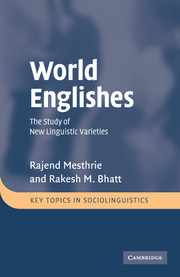Book contents
- Frontmatter
- Contents
- List of figures
- List of tables
- Preface
- Acknowledgements
- List of abbreviations
- 1 History: the spread of English
- 2 Structural features of New Englishes I: morphology and phrasal syntax
- 3 Structural features of New Englishes II: cross-clausal syntax and syntactic theory
- 4 More on structure: lexis and phonology
- 5 Pragmatics and discourse
- 6 Language contact and language acquisition issues in New English research
- 7 Conclusion: current trends in the spread of English
- Glossary
- Bibliography
- Author index
- Subject index
6 - Language contact and language acquisition issues in New English research
Published online by Cambridge University Press: 05 September 2012
- Frontmatter
- Contents
- List of figures
- List of tables
- Preface
- Acknowledgements
- List of abbreviations
- 1 History: the spread of English
- 2 Structural features of New Englishes I: morphology and phrasal syntax
- 3 Structural features of New Englishes II: cross-clausal syntax and syntactic theory
- 4 More on structure: lexis and phonology
- 5 Pragmatics and discourse
- 6 Language contact and language acquisition issues in New English research
- 7 Conclusion: current trends in the spread of English
- Glossary
- Bibliography
- Author index
- Subject index
Summary
INTRODUCTION
This chapter is concerned with issues pertaining to the acquisition of New Englishes. Our first task is to locate New Englishes as a class within the wider field of language contact. In particular we examine the views of scholars who see considerable overlaps between New Englishes and other contact varieties like Creoles. This necessitates a closer look at the role and nature of the superstrate, at the role and nature of substrate languages and at the possibility of ‘universals’ of language contact. However, since – unlike most contact varieties – New Englishes are to a large extent the products of educational systems, they also warrant an examination in terms of findings in the field of Second Language Acquisition (SLA). Finally, since some New Englishes are showing signs of becoming first languages for some of their users, certain perspectives from the study of language shift are necessary. Most studies concerned with these issues have focused on the syntax of specific New Englishes. We begin with the field of SLA.
NEW ENGLISHES AND SECOND LANGUAGE ACQUISITION: A PARADIGM GAP?
Given that New Englishes arose mainly in situations of bilingualism stimulated by classroom education, it is a natural expectation that they should be characterised, especially at earlier stages of development, in terms of the processes of SLA. To date this is an under-researched area in New English studies. Sridhar and Sridhar (1986) referred to this lack of interface between SLA studies and New English as ‘a paradigm gap’.
- Type
- Chapter
- Information
- World EnglishesThe Study of New Linguistic Varieties, pp. 156 - 199Publisher: Cambridge University PressPrint publication year: 2008

